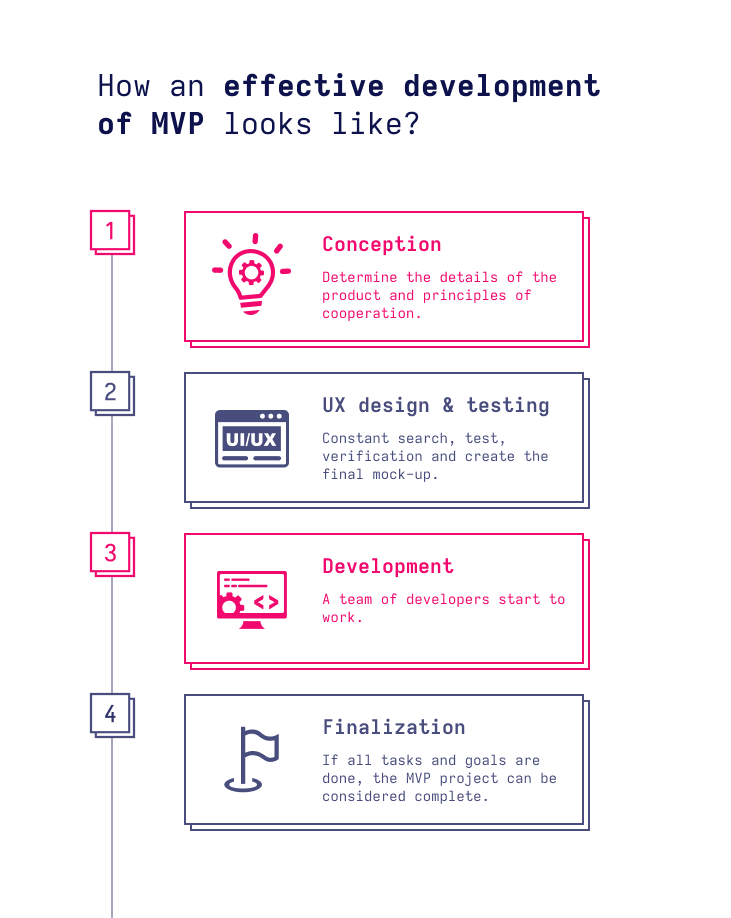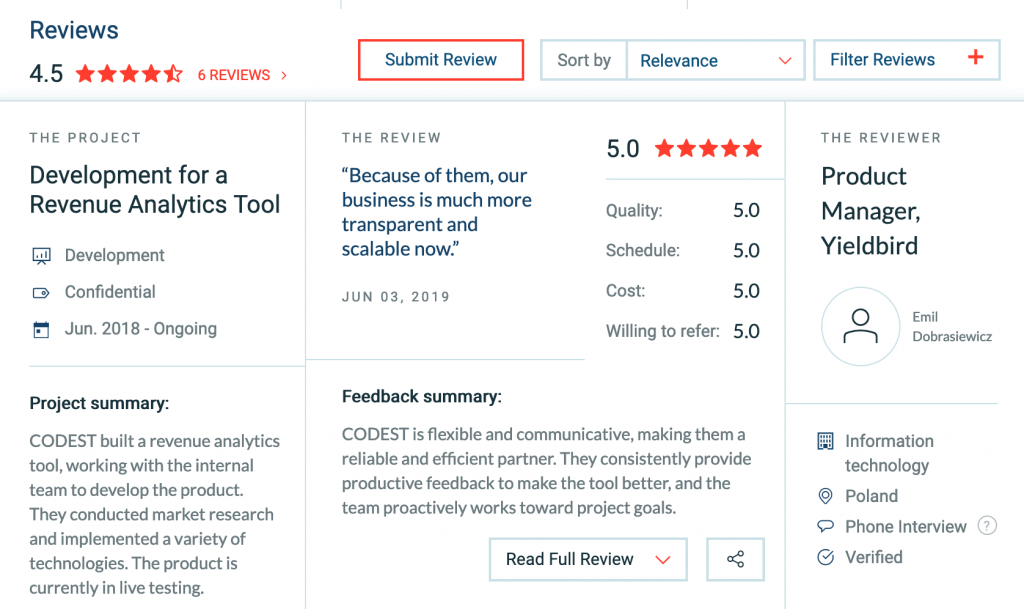Ranking of Top E-commerce Companies in Texas
Texas is a land known for its vast horizons and pioneering spirit, a state where tradition meets innovation.
 GO BACK
GO BACK
An MVP (Minimum Viable Product) approach is a strategy for product development and implementation onto the market often chosen by startups (but not only them!). It is a cost-effective solution that allows you to save a portion of the budget, avoid making wrong decisions, and better adjust the product to market conditions and customers’ preferences.
The Codest has completed many such projects. Each of them taught us something new. We have worked with clients from various industries – fintech, adtech, marktech,e-commerce – each with their own individual needs and daily challenges. Based on this experience, I decided to share with you my suggestions and good practices for MVP building and implementation. Hopefully, you will find it useful.
I invite you to my short guide. But first…
An MVP is a product at an early stage of development, with a minimum set of features, which, however, are sufficient to introduce the product to the market in order to attract the interest of the first customers and allow for a preliminary evaluation of functionality.
The main goal of the MVP-based approach is to obtain customer feedback about the product and its functionalities.

The starting point. I suppose you have a great idea in your head and you think that this will be a real gold mine, don’t you? So, it’s time to build this product and start earning. A great prospect, right? Unfortunately, this is not as simple as it may seem. The most common mistakes at the stage of creating an MVP occur at the very beginning, i.e. when defining the target audience.
Here are some important points that must not be forgotten:
This choice is also one of the most important ones prior to actually building an MVP . The technology in which you build the product will also determine its development. First of all, the technology must be adapted to the specificity of the product. Secondly, you should make a choice that will facilitate the development and scalability later on.
Remember about costs as well; they play an important role for many startups. If you are not a tech-savvy person, it is best to consult your choice with the development team who will build this product for you. They have the experience and knowledge of the technological solution that will be best for you.
At The Codest, we often [develop MVPs using Ruby] (https://thecodest.co/blog/why-is-building-a-mvp-possible-with-ruby-on-rails/)pt and its Rails framework. Our customers appreciate the quick development process and the ease of introducing changes to the code, which not only accelerates development, but also provides great flexibility. Of course, this is just one of the options and your choice should be very thought-out. So, remember – technology matters!
An MVP should contain the basic and most important functionalities that enable implementing the product on the market, gathering feedback and further improving the product. Remember that you start your MVP by creating a list of the most important traits only. Focus on them. Create an MVP, show the value of your product, see how the market reacts, and only then develop new functionalities.
Ok, you can say that this step is only logical, but still many people forget about it. Customers often want to get as much as possible in the shortest possible time. Meanwhile, this is not the best way to get things done and this is not the idea behind the MVP approach . Do not forget that an MVP does not equal an unfinished product!
Here are my tips to help you identify the features your MVP product really needs to have. Start with the analysis below:
Necessary set of features that will enable your product to function and allow customers to judge its value in use.
Features that your product should gain over time to develop and increase its value. At this point, it is worthwhile for each feature to have a defined priority, so that you know what should be developed at which stage.
In this case, features or functionalities the implementation of which at the moment is conceptually unjustified or there are other limitations (for example, technical).
Here, the matter is quite simple – features that your product will not have. How to get there? It may turn out that, on the basis of analysis or tests, certain functionalities are described by customers as useless or they simply do not like them. Then you will know that you need to stay away from them.
If you intend to enter the market with a product, make sure that nothing identical exists there. Of course, you may come across a product with similar characteristics to yours, that’s nothing unusual. However, remember about Unique Selling Points! Your product should have at least one new feature (value) that you can use to convince your target group to choose your offer.
Of course, you can create something that perfectly copies a successful product that is already on the market. However, as you can guess, the chances of such a business bringing high profits are drastically reduced from the very beginning. Therefore, we advise against such a strategy.
When building an MVP, you need to take care of the team of developers who will create the product that you have in mind. It is not that simple. Finding real specialists is one thing. Another issue is to make them understand the specifics of the product and its needs. You have to be sure that the team you work with understands your vision and shares it.
A team is more than just a group of people following your orders. Their knowledge, especially from the perspective of the technologies that may be used, has an impact on the shape of your product and its future. It is best to look for real specialists who have experience in similar projects to yours. The Clutch portal is a good source of information. IT gives access to tons of companies that you can potentially cooperate with.

Quite often choosing a methodology for your IT project management becomes a real dilemma. In most cases, it concerns two methodologies: Agile and Waterfall. They differ in their characteristics, which affect the way the project is implemented. Both solutions have their strengths and weaknesses.
It can be said that the Waterfall methodology is a more standard approach as it was definitely used more often at some point. The dynamic development of the IT industry led to searching for an alternative method that would further improve the effectiveness of IT projects. To address this need, the Agile methodology was created. Currently, both approaches have their supporters. There is an ongoing debate about which of these methodologies is more effective.
To be honest, I am big fan of Agile. It is better suited for large projects. Thanks to this approach, the first results can be visible much sooner. The development team focuses on the creation of a given functionality at a specific time and then proceeds to the next one. In this way, the product acquires its first features from the very beginning. Agile is also appreciated for its great flexibility and ability to make changes at various stages of the project.
I hope these few tips that I present to you in this article will be helpful during the MVP product building process. Remember about each tip so that you don’t sweep something, don’t miss anything, and most importantly – don’t make frequently repeated mistakes! This way you will increase the chance of your success in minimum viable product development. I wish you many great experiences with your MVPs!
In the MVP product building process, it’s crucial to focus on the target users and the business model that underpins your minimum viable product. The mvp software development stage is more than just coding; it involves thorough market research and understanding the needs of your potential customers.
A successful minimum viable product often starts with a solid foundation in mobile app development, especially if your mvp development process is aimed at a mobile-first audience. Remember, during the development stage, agility is key. Agile development and a well-planned mvp launch can significantly increase the likelihood of creating a successful MVP, while reducing the risks of product failure.
Lastly, your product team plays a crucial role in the success of your minimum viable product. Encourage collaboration, innovation, and flexibility to adapt to the market’s needs, which will ultimately contribute to the development of a future-proof and future product.